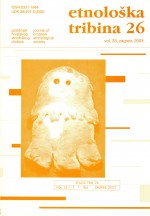Narodna umjetnost u Splitu
Folk Art in the Town of Split
Author(s): Branka Vojnović-TraživukSubject(s): Fine Arts / Performing Arts, Customs / Folklore, Ethnohistory, Cultural Anthropology / Ethnology, 19th Century, Pre-WW I & WW I (1900 -1919), Interwar Period (1920 - 1939)
Published by: Hrvatsko etnološko društvo
Keywords: folk artistic expression; Split; urban culture;
Summary/Abstract: The paper examines an evaluation of the folk artistic expression in the popular culture of Split between the late 19th century and the beginning of the Second World War. Several private or school collections existed and exhibitions of traditional handcrafts were held in Dalmatia before the founding of the Ethnographic Museum of Split in 1910. In the beginning the Museum work was closely connected to the Crafts School and later to the manual training held in the Banovinska poslovnica. An important activity was the development of artistic handcrafts based on folk motifs and techniques. Final products were decorative artifacts and souvenirs. The folk expression was adapting itself to current culture movements and the process of national identification that was going on in the town. These influences made the beginning of the transformation of traditional life in general. Functional and formative changes of the folk artistic expression prove the existence of strong interactions between the urban and rural culture. Such an interpretation of traditional culture was a cultural process that was typical of Split, though it was also in accordance with similar movements in Zagreb, the capital of Croatia. In this dynamic relation between folk artistic expression and its reception in the town, various interpretations of folk art were taking place, through which objects of ethnography were transformed from rarities into souvenirs.
Journal: Etnološka tribina : Godišnjak Hrvatskog etnološkog društva
- Issue Year: 33/2003
- Issue No: 26
- Page Range: 23-34
- Page Count: 12
- Language: Croatian

